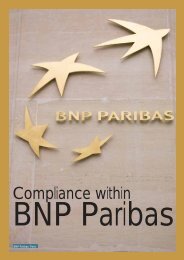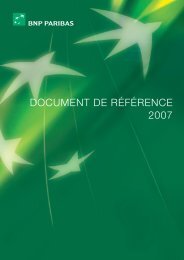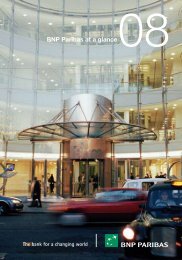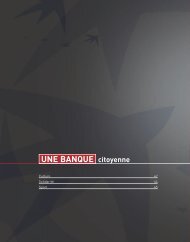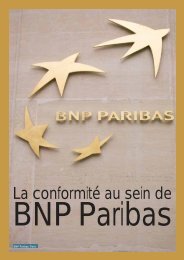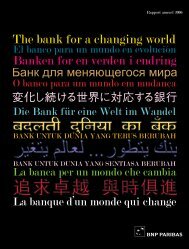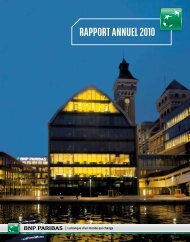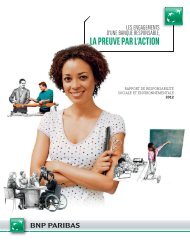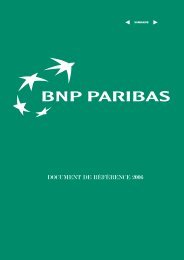2007 REGISTRATION DOCUMENT
2007 REGISTRATION DOCUMENT
2007 REGISTRATION DOCUMENT
- No tags were found...
Create successful ePaper yourself
Turn your PDF publications into a flip-book with our unique Google optimized e-Paper software.
CONSOLIDATED FINANCIAL STATEMENTS5Notes to the financial s tatements p repared in accordance with I nternational Financial Reporting S tandards as adopted by the European Union< Contents >1.f LEASESGroup companies may be either the lessee or the lessor in a leaseagreement.1.f.1Lessor accountingLeases contracted by the Group as lessor are categorised as either financeleases or operating leases.Finance leasesIn a finance lease, the lessor transfers substantially all the risks andrewards of ownership of an asset to the lessee. It is treated as a loanmade to the lessee to finance the purchase of the asset.The present value of the lease payments, plus any residual value, isrecognised as a receivable. The net income earned from the lease bythe lessor is equal to the amount of interest on the loan, and is taken tothe profit and loss account under “Interest income”. The lease paymentsare spread over the lease term, and are allocated to reduction of theprincipal and to interest such that the net income reflects a constantrate of return on the net investment outstanding in the lease. The rateof interest used is the rate implicit in the lease.Individual and portfolio impairments of lease receivables are determinedusing the same principles as applied to other loans and receivables.Operating leasesAn operating lease is a lease under which substantially all the risksand rewards of ownership of an asset are not transferred to the lessee.The asset is recognised under property, plant and equipment in thelessor’s balance sheet and depreciated on a straight-line basis over thelease term. The depreciable amount excludes the residual value of theasset. The lease payments are taken to the profit and loss account infull on a straight-line basis over the lease term. Lease payments anddepreciation expense are taken to the profit and loss account under“Income from other activities” and “Expenses on other activities”.1.f.2Lessee accountingLeases contracted by the Group as lessee are categorised as either financeleases or operating leases.Finance leasesA finance lease is treated as an acquisition of an asset by the lessee,financed by a loan. The leased asset is recognised in the balance sheetof the lessee at the lower of its fair value or the present value of theminimum lease payments calculated at the interest rate implicit in thelease. A matching liability, equal to the fair value of the leased asset orthe present value of the minimum lease payment, is also recognised inthe balance sheet of the lessee. The asset is depreciated using the samemethod as that applied to owned assets, after deducting the residualvalue from the amount initially recognised, over the useful life of theasset. The lease obligation is accounted for at amortised cost.Operating leasesThe asset is not recognised in the balance sheet of the lessee. Leasepayments made under operating leases are taken to the profit and lossaccount of the lessee on a straight-line basis over the lease term.1.g NON-CURRENT ASSETS HELD FOR SALEAND DISCONTINUED OPERATIONSWhere the Group decides to sell non-current assets and it is highlyprobable that the sale will occur within twelve months, these assets areshown separately in the balance sheet, on the line “Non-current assetsheld for sale”. Any liabilities associated with these assets are also shownseparately in the balance sheet, on the line “Liabilities associated withnon-current assets held for sale”.Once classified in this category, non-current assets and groups of assetsand liabilities are measured at the lower of carrying amount or fair valueless costs to sell.Such assets are no longer depreciated. If an asset or group of assets andliabilities becomes impaired, an impairment loss is recognised in theprofit and loss account. Impairment losses may be reversed.Where a group of assets and liabilities held for sale represents a majorbusiness line, it is categorised as a “discontinued operation”. Discontinuedoperations include operations that are held for sale, operations thathave been shut down, and subsidiaries acquired exclusively with a viewto resale.All gains and losses related to discontinued operations are shownseparately in the profit and loss account, on the line “Post-tax gain/losson discontinued operations and assets held for sale”. This line includesthe post-tax profits or losses of discontinued operations, the post-taxgain or loss arising from remeasurement at fair value less costs to sell,and the post-tax gain or loss on disposal of the operation.1.h EMPLOYEE BENEFITSEmployee benefits are classified in one of four categories:■ short-term benefits such as salary, annual leave, incentive plans,profit-sharing and additional payments;■ long-term benefits, including compensated absences, long-serviceawards, and other types of cash-based deferred compensation;■ termination benefits;■ post-employment benefits, including top-up banking industry pensionsin France and pension plans in other countries, some of which areoperated through pension funds.1.h.1Short-term benefitsThe Group recognises an expense when it has used services rendered byemployees in exchange for employee benefits.1234567891011<strong>2007</strong> Registration document - BNP PARIBAS 125



